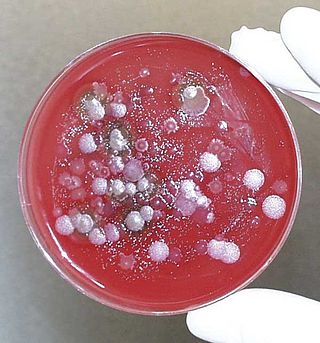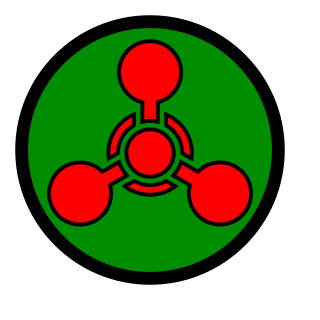Related Research Articles

Biological warfare, also known as germ warfare, is the use of biological toxins or infectious agents such as bacteria, viruses, insects, and fungi with the intent to kill, harm or incapacitate humans, animals or plants as an act of war. Biological weapons are living organisms or replicating entities. Entomological (insect) warfare is a subtype of biological warfare.

The Convention on Biological Diversity (CBD), known informally as the Biodiversity Convention, is a multilateral treaty. The Convention has three main goals: the conservation of biological diversity ; the sustainable use of its components; and the fair and equitable sharing of benefits arising from genetic resources. Its objective is to develop national strategies for the conservation and sustainable use of biological diversity, and it is often seen as the key document regarding sustainable development.

The Cartagena Protocol on Biosafety to the Convention on Biological Diversity is an international agreement on biosafety as a supplement to the Convention on Biological Diversity (CBD) effective since 2003. The Biosafety Protocol seeks to protect biological diversity from the potential risks posed by genetically modified organisms resulting from modern biotechnology.
The Protocol for the Prohibition of the Use in War of Asphyxiating, Poisonous or other Gases, and of Bacteriological Methods of Warfare, usually called the Geneva Protocol, is a treaty prohibiting the use of chemical and biological weapons in international armed conflicts. It was signed at Geneva on 17 June 1925 and entered into force on 8 February 1928. It was registered in League of Nations Treaty Series on 7 September 1929. The Geneva Protocol is a protocol to the Convention for the Supervision of the International Trade in Arms and Ammunition and in Implements of War signed on the same date, and followed the Hague Conventions of 1899 and 1907.

The Chemical Weapons Convention (CWC), officially the Convention on the Prohibition of the Development, Production, Stockpiling and Use of Chemical Weapons and on their Destruction, is an arms control treaty administered by the Organisation for the Prohibition of Chemical Weapons (OPCW), an intergovernmental organization based in The Hague, The Netherlands. The treaty entered into force on 29 April 1997. It prohibits the use of chemical weapons, and also prohibits large-scale development, production, stockpiling, or transfer of chemical weapons or their precursors, except for very limited purposes. The main obligation of member states under the convention is to effect this prohibition, as well as the destruction of all current chemical weapons. All destruction activities must take place under OPCW verification.

A weapon of mass destruction (WMD) is a biological, chemical, radiological, nuclear, or any other weapon that can kill or significantly harm many people or cause great damage to artificial structures, natural structures, or the biosphere. The scope and usage of the term has evolved and been disputed, often signifying more politically than technically. Originally coined in reference to aerial bombing with chemical explosives during World War II, it has later come to refer to large-scale weaponry of warfare-related technologies, such as biological, chemical, radiological, or nuclear warfare.

The Biological Weapons Convention (BWC), or Biological and Toxin Weapons Convention (BTWC), is a disarmament treaty that effectively bans biological and toxin weapons by prohibiting their development, production, acquisition, transfer, stockpiling and use. The treaty's full name is the Convention on the Prohibition of the Development, Production and Stockpiling of Bacteriological (Biological) and Toxin Weapons and on their Destruction.

The Convention on the Prohibition of the Use, Stockpiling, Production and Transfer of Anti-Personnel Mines and on their Destruction of 1997, known informally as the Ottawa Treaty, the Anti-Personnel Mine Ban Convention, or often simply the Mine Ban Treaty, aims at eliminating anti-personnel landmines (APLs) around the world.

The United States is known to have possessed three types of weapons of mass destruction: nuclear weapons, chemical weapons, and biological weapons. The U.S. is the only country to have used nuclear weapons on another country, when it detonated two atomic bombs over two Japanese cities of Hiroshima and Nagasaki during World War II. It had secretly developed the earliest form of the atomic weapon during the 1940s under the title "Manhattan Project". The United States pioneered the development of both the nuclear fission and hydrogen bombs. It was the world's first and only nuclear power for four years, from 1945 until 1949, when the Soviet Union produced its own nuclear weapon. The United States has the second-largest number of nuclear weapons in the world, after the Russian Federation.

A biological agent is a bacterium, virus, protozoan, parasite, fungus, or toxin that can be used purposefully as a weapon in bioterrorism or biological warfare (BW). In addition to these living or replicating pathogens, toxins and biotoxins are also included among the bio-agents. More than 1,200 different kinds of potentially weaponizable bio-agents have been described and studied to date.

Poland is not known or believed to possess weapons of mass destruction. During the Cold War, Soviet nuclear warheads were stockpiled in Poland and designated to deploy within the Polish People's Army. Poland was also working with Russia to help eliminate the large stockpiles of chemical and biological weapons developed by the Warsaw Pact countries. Poland ratified the Geneva Protocol on 4 February 1929.
The United States biological weapons program officially began in spring 1943 on orders from U.S. President Franklin Roosevelt. Research continued following World War II as the U.S. built up a large stockpile of biological agents and weapons. Over the course of its 27-year history, the program weaponized and stockpiled the following seven bio-agents :

The Soviet Union covertly operated the world's largest, longest, and most sophisticated biological weapons program, thereby violating its obligations as a party to the 1972 Biological Weapons Convention. The program began in the 1920s and lasted until at least September 1992 but has possibly been continued by Russia after that.
The International Health Regulations (IHR), first adopted by the World Health Assembly in 1969 and last revised in 2005, are a legally binding rules that only apply to the WHO that is an instrument that aims for international collaboration "to prevent, protect against, control, and provide a public health response to the international spread of disease in ways that are commensurate with and restricted to public health risks and that avoid unnecessary interference with international traffic and trade". The IHR is the only international legal treaty with the responsibility of empowering the World Health Organization (WHO) to act as the main global surveillance system.

A chemical weapon (CW) is a specialized munition that uses chemicals formulated to inflict death or harm on humans. According to the Organisation for the Prohibition of Chemical Weapons (OPCW), this can be any chemical compound intended as a weapon "or its precursor that can cause death, injury, temporary incapacitation or sensory irritation through its chemical action. Munitions or other delivery devices designed to deliver chemical weapons, whether filled or unfilled, are also considered weapons themselves."
The general-purpose criterion is an important concept in international law that broadly governs international agreements with respect to, for instance biological and chemical weapons. Although the term is not found within such agreements, it is "regularly used" to describe the comprehensive nature of prohibitions regarding all biological and chemical weapons.
The United States Biological Defense Program—in recent years also called the National Biodefense Strategy—refers to the collective effort by all levels of government, along with private enterprise and other stakeholders, in the United States to carry out biodefense activities.
The United Nations Secretary-General's Mechanism for Investigation of Alleged Use of Chemical and Biological Weapons (UNSGM), is a tool that allows the Secretary-General to investigate alleged uses of biological or chemical weapons. The UNSGM is not a standing investigative body, but instead relies on a member state-provided list of qualified experts, consultants, and analytical laboratories that may be activated on short notice to support UNSGM investigations.
References
- 1 2 3 4 Final Document of the Third Review Conference to the Biological Weapons Convention (Geneva, 9–27 September 1991). BWC/CONF.III/23. pp., 16-18.
- ↑ Duncan, Annabelle, and Robert J. Mathews. 1996. “Development of a Verification Protocol for the Biological Weapons Convention”, in Poole, J.B. and R. Guthrie (eds). Verification 1996: Arms Control, Peacekeeping and the Environment. pp. 151–170. VERTIC.
- ↑ "Biological Weapons Convention | Biological Weapons Warfare Treaty | NTI". Nuclear Threat Initiative . Retrieved 2020-11-13.
- 1 2 3 4 5 6 7 VEREX Final Report (Geneva, 1993). BWC/CONF.III/VEREX/9.
- ↑ Lentzos, Filippa (2019). "Compliance and Enforcement in the Biological Weapons Regime". United Nations Institute for Disarmament Research . doi: 10.37559/WMD/19/WMDCE4 .
- ↑ de Jonge, Boudewijn (January 2006). "A Socio-Legal Analysis of the Failed Establishment of the Organisation for the Prohibition of Biological Weapons" (PDF). Archived from the original (PDF) on 2007-06-21.
- 1 2 "The Biological Weapons Convention (BWC) At A Glance | Arms Control Association". www.armscontrol.org. Retrieved 2021-02-10.
- ↑ Ad Hoc Group (April, 2001). “Protocol to the Convention on the Prohibition of the Development, Production and Stockpiling of Bacteriological (Biological) and Toxin Weapons and on Their Destruction”, BWC/AD HOC GROUP/CRP.8.
- ↑ Beard, J. (2007). "The Shortcomings of Indeterminacy in Arms Control Regimes: The Case of the Biological Weapons Convention". American Journal of International Law. 101(2): 271–321. doi:10.1017/S0002930000030098. p., 283-284
- ↑ Mahley, Donald. 2001. “Statement of the United States to the Ad Hoc Group of Biological Weapons Convention States Parties”. 25 July 2001.
- ↑ Peter Slevin (19 September 2002). “U.S. Drops Bid to Strengthen Germ Warfare Accord”, Washington Post.